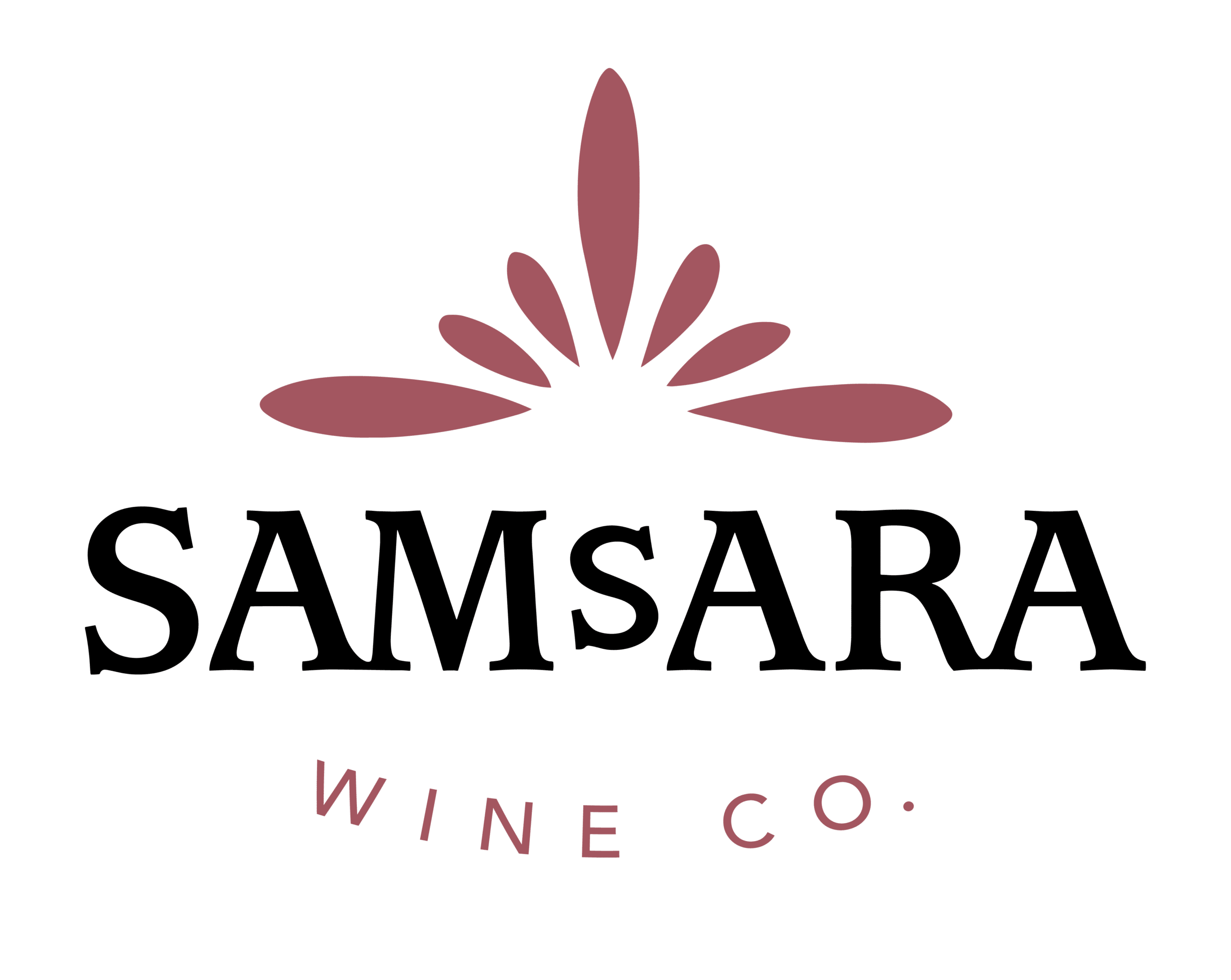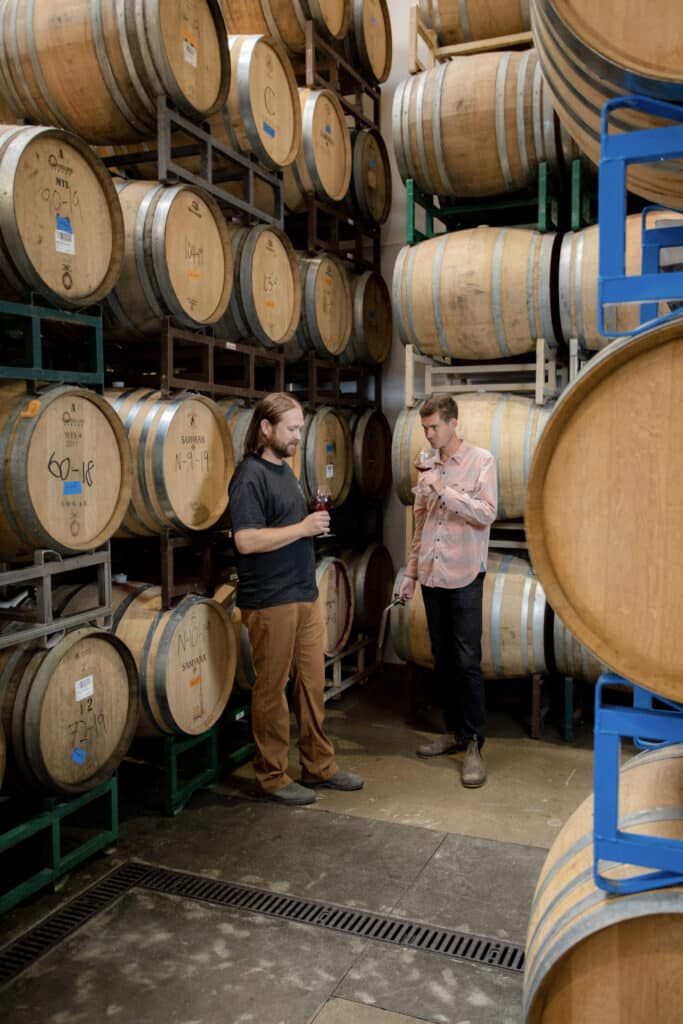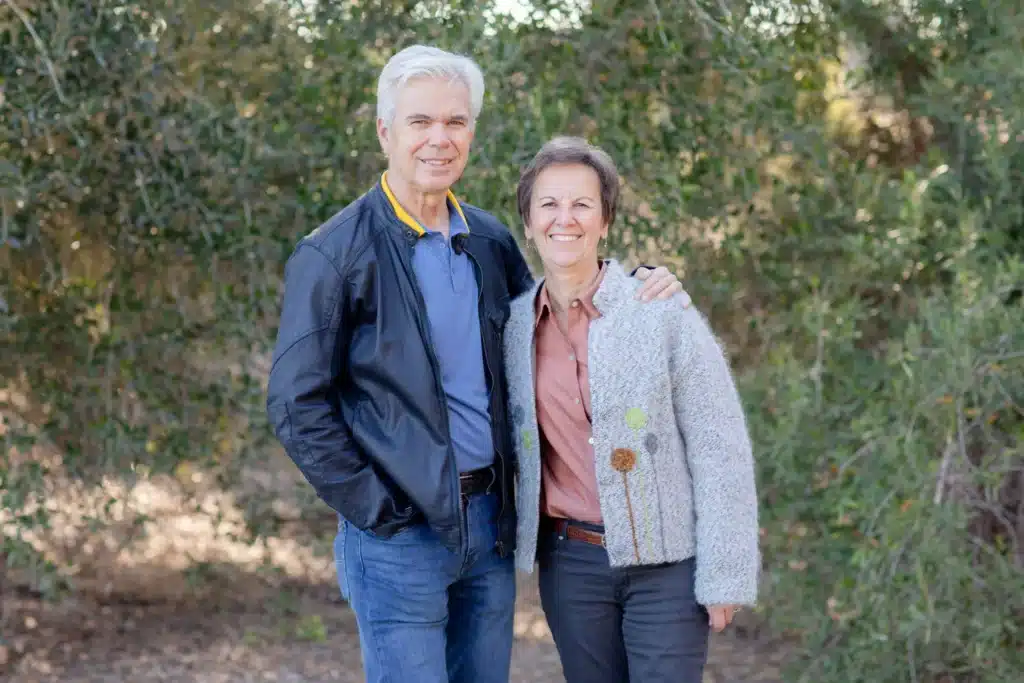No products in the cart.
What Is Terroir and WHY IS TERROIR Important?
While the literal English translation of the French word is “land”, the true meaning encompasses much more than the soil in which grapevines are grown.
Today, terroir is most often associated with the full range of influences that impact the growing and winemaking environments. These include the soil (composition, drainage), biodiversity features (the range of micro and macro organisms in the ecosystem), terrain/topography (vineyard orientation, altitude, aspect, slope), and climate (latitude, temperature, humidity, rainfall sunshine, wind), While all of these elements are naturally occurring, both farming practices as well as winemaking practices and traditions can alter these elements positively or negatively, and contribute to terroir.
Simply put, terroir conveys a sense of place and time.
SOIL AND TERROIR
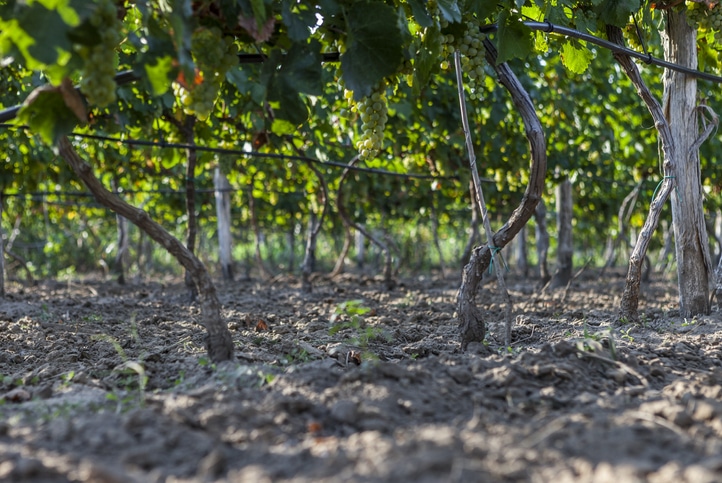
Soil is one of the most obvious components of terroir, yet is perhaps not the most critical. Grapevines are very tolerant and can grow in a wide range of soil types from very loose sandy soils to more compact clay soils and everything in between. Vines need very small amounts of nutrients like Nitrogen, Potassium, Phosphorous, Calcium, and Magnesium to grow. What’s more important than the actual soil type is the soil’s ability to hold water and nutrients which are vital to the vine’s growth and fruit bearing potential.
Grapevines tend to be very vigorous plants that can grow wildly with plentiful water and sunshine. However, an overgrown plant is likely to produce fruit that is acidic and lacks complexity…fine for the birds, but not for great wine. To produce quality wine grapes, vines should somewhat struggle to grow. Struggle ensures the vines concentrate their resources on ripening a small amount of fruit versus a lot of shoot and leaf growth. The best soils for vines are those that drain quickly after rain so the roots are not waterlogged, but can hold onto enough water for the dryer periods of the vine’s growth cycle (summer).
To illustrate, Bordeaux is noted for its gravelly, stony soils that drain water quickly and radiate the warmth of the daytime sun back to the vines at night. These soils are critical to producing some of the finest wines in the world.
Here in Sta. Rita Hills, we have a wide variety of soils producing quality grapes. Three examples that convey the range of soil types in the Sta. Rita Hills AVA are our Zotovich Vineyard, Las Hermanas and La Encantada Vineyards.
Zotovich Vineyard has a distinctive soil composition of deep sand and diatomaceous earth. As you may know, diatomaceous earth, often referred to as DE, was created from the deposited fossils of ancient marine diatoms, single celled algae with silica based exoskeletons. This fossil based soil type has excellent water retention qualities, able to absorb 1.5 to 3 times its weight in water.
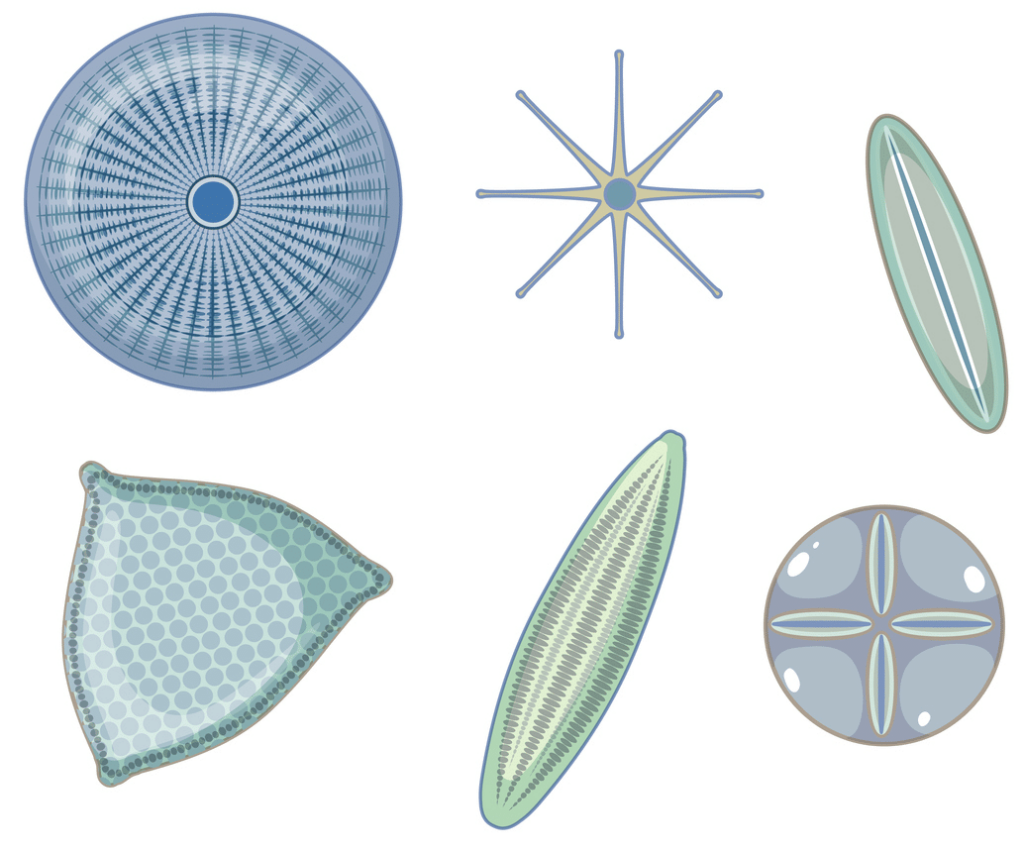
Las Hermanas is planted on six different soil types all of them based on fossilized ancient marine life. Our vines are located near the top of the hill where the aggressive sloping helps ensure water drains quickly.
The unique soil composition (deep sand and DE) at Zotovich Vineyard Diatomaceous earth is very rare as a soil type and is prized within the Sta. Rita Hills AVA and both our Syrah and Chardonnay vines perform exceptionally well here.
Our La Encantada Vineyard has very different soils that have heavier, loamy/sandy soil and the vines SAMsARA uses are over 20 years old. The age of the vines combined with the soil composition makes La Encantada one of our lowest yielding vineyards, providing small berries with concentrated flavor and tannin. We love our Pinot Noirs from this vineyard for their excellent structure.
CLIMATE, TOPOGRAPHY, AND TERROIR
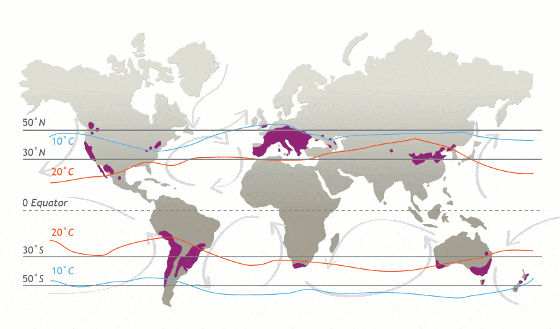
Photo credit www.thirtyfifty.co.uk/wine-regions.asp
Grapes grown in cooler regions (Germany, Northern France, Tasmania) are characterized by higher acidity, lower body and alcohol, and more tart fruit flavors (green apple, lemon, sour cherry, herbal notes). Grapes grown in warmer regions (Australia, Spain, Italy) tend to have lower acidity, higher alcohol and body and more ripe fruit flavors (peaches, pineapples, black cherry, plums). This has to do with chemical reactions that occur within the grape as temperatures rise or fall and as the grape is exposed to sunlight.
Water, in the forms of rainfall and proximity to a body of water, can also have a massive impact on terroir. In general, vines need between 20 inches and 30 inches of water per year. Water is a key component in photosynthesis, temperature regulation, and the transport of nutrients from the soil. While many vineyards in California require irrigation given the low level of rainfall, the best use only a small amount of irrigation water. This ensures the vine roots must dig deep for water and ensures the vine concentrates resources into a small number of grapes.
Proximity to water also has an important impact on vineyards and in some cases makes viticulture possible (New York Finger Lakes, Niagara On the Lake in Canada). Here, large bodies of water heat up and cool down more slowly than dry land. Vineyards near these large bodies of water are impacted with areas like the Finger Lakes being warmer than the rest of upstate New York where vine growth is not possible due to the extreme cold.
In Sta.Rita Hills, the proximity to the Pacific Ocean plays a significant role in the quality of our grapes. Cool afternoon breezes not only lower the temperature in the vineyards, but also keep the vines dry which helps prevent the formation of harmful fungal diseases common to many grave vines. The ocean also funnels in dense fog which can block the intense sunlight of Southern California ensuring the grapes don’t become sunburnt.
Radian Vineyard is an extreme example of this effect. The top of the hill where the SAMsARA Pinot Noir is planted is the most exposed part of the vineyard. Often when we are at the vineyard near the end of the season, it can feel like a fog hurricane is raging and you can’t see six feet in front of your face! In these extreme conditions, you rarely get grape clusters the size of your fist. The berries are incredibly small and intense and we’re honored to get to showcase them in our wines.
LANDSCAPE FEATURES AND TERROIR
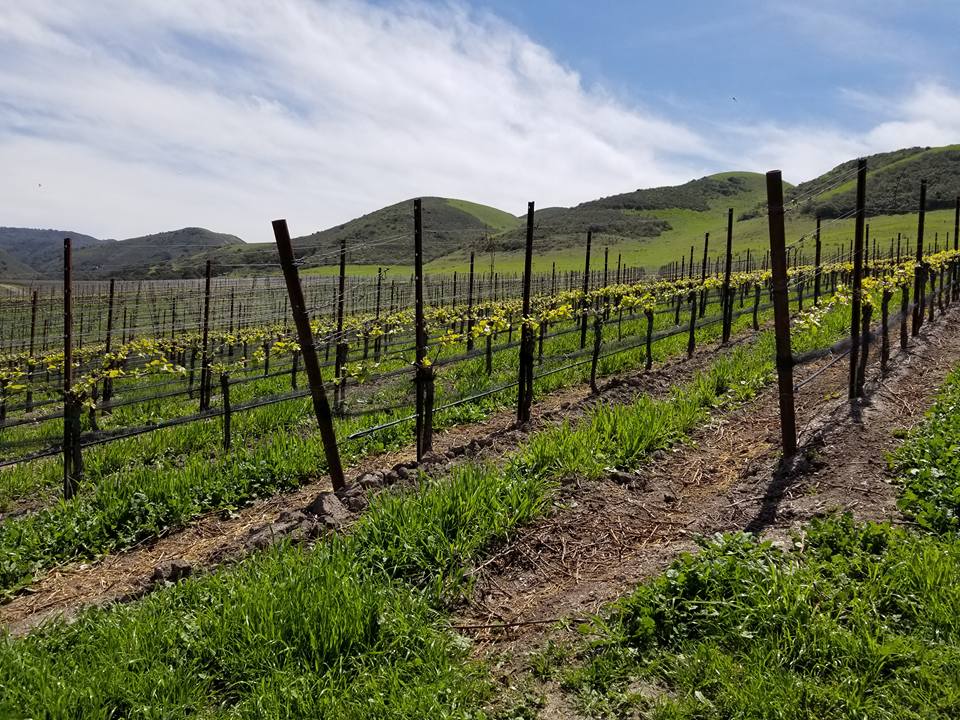
Altitude and aspect play an important role in terroir for a variety of reasons. First, altitude has a direct impact on average temperature. For every 300 feet of altitude increase, the temperature will drop by on average 1° Fahrenheit. This can be helpful in warmer areas like Argentina where vines can be planted as high as 11,000 feet above sea level.
In Sta. Rita Hills, the Rancho La Viña vineyard site is on a sloped mesa several hundred feet above the valley floor. It is fully exposed to the cool air coming off the Pacific Ocean and is one of the coldest Pinot Noir vineyards in all of California. This along with the slightly richer soils composed largely of loam clay, yield very small berries with remarkably deep color and intense flavors.
Radian vineyard is another vineyard planted on a slope, but it is much steeper than that of Rancho La Viña. Here the slope can be STEEP making work difficult. In the northern hemisphere, sites planted on south facing slopes can get more sunlight than those on flatter land due to the angle of light interception and the converse is true for sites planted on north facing slopes.
Turner Vineyard, in the very north of Sta. Rita Hills also has a high elevation and is made up of several rolling hills and a mesa. These sites all have different altitudes and aspects which allows our winemaker to produce a wine of great complexity. The lower altitude vines provide richness and body while the higher altitude vines contribute more freshness and acidity. Together these sites produce a wine with balance and layers of complexity.
Soils on slopes are also generally lower in vigor (lower shoot and leaf growth and hence lower fruit yield) and more quickly draining than those on flat land. This keeps the vine from becoming too comfortable and therefore concentrates its energy on producing quality fruit. Our Radian Vineyard Pinot Noir is a great example of this phenomenon. It’s a wine of intense tannin and acid structure for a wine with exceptional ageability.
HUMAN IMPACT ON TERROIR
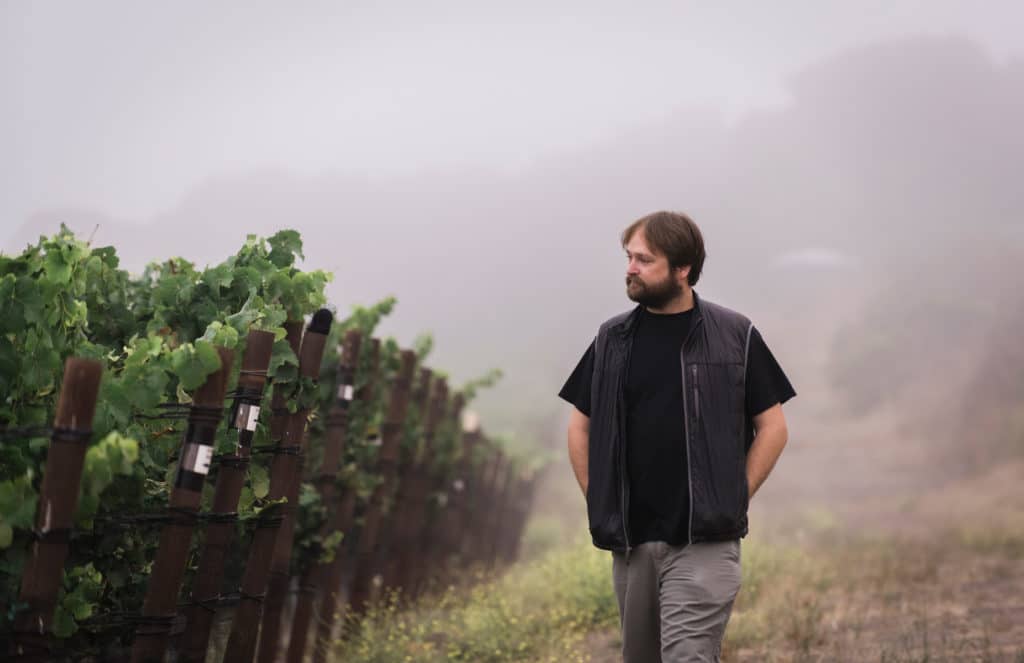
How a vineyard is farmed and cared for can have a dramatic impact on the terroir of the site. While people have little control over the weather, they have much control over what they put into and take out of the soil.
Farmers who use chemicals such as pesticides and herbicides may have more disease-free plants, but as these chemicals leach into the ground they can also inadvertently harm or kill beneficial animals and organisms that are vital to the ecosystem. This can lead to dead soils that don’t have enough nutrients or oxygen for the vine to thrive.
Farmers who work organically, preserve our area’s incredible biodiversity, making for healthier plants that produce clean fruit year after year. These stewards of the land use organic compounds like manure or compost to ensure the vine has the nutrients it needs and natural methods to control pests and weeds.
We are proud of our work at SAMsARA to encourage the growers we work with to adopt organic practices. Not only is organic farming better for the Earth and its delicate ecosystems, but it’s good for the health of farmers themselves, the grapes they raise, and the wines we make. Larner, Bentrock, Radian, and Rancho La Viña vineyards are some of the vineyards we work with that are organically farmed. For the 2022 harvest, our goal is to only source fruit from 100% organically farmed vineyards.
Is Terroir Important?
In a word, yes. But why?
As low-intervention winemakers, terroir is at the heart of what we do. Our intention is to source the very best fruit and to let terroir be the star. We do not shrink from making intentional, handmade wines that truly reflect the unique moment in time and space when our grapes were grown. We firmly believe that working with growers to produce the best fruit possible and then using low-intervention practices is the very best way to let the terroir speak for itself and create wines that both taste great when young, but are also worthy of significant age
As a wine drinker, understanding terroir can give you a better appreciation of how low-intervention winemaking can accentuate subtle differences between wines of the same grape grown in different locations from just a few yards to many thousands of miles apart.
Understanding the beautiful and complex factors that contribute to terroir can also help you choose wineries and grape growers who have respect for the land, the crop, and the ecosystems of which they are a part.
Want to explore a special collection of wines from vineyards mentioned in this article? Visit our Terroir Collections HERE.
Learn more about the Terroir of Santa Barbara County
